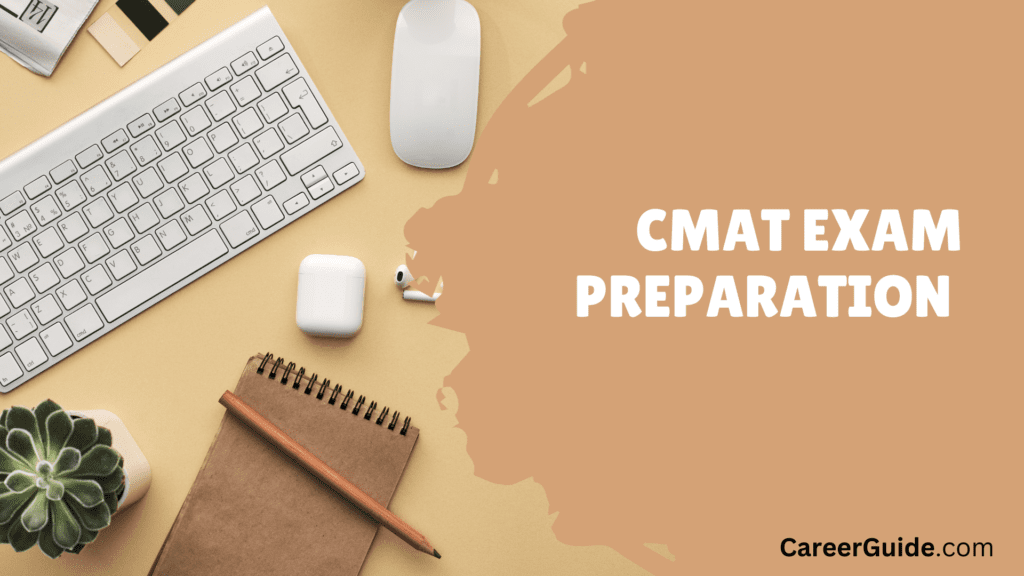CMAT Exam Preparation: Planning for the Common Administration Confirmation Test (CMAT) could be a pivotal step for people yearning to seek after a career in management or commerce organization. CMAT could be a national-level entrance exam in India that surveys a candidate’s inclination in different ranges such as quantitative techniques, coherent thinking, dialect comprehension, and common mindfulness.
In this comprehensive direct, we are going investigate all perspectives of CMAT exam planning, counting an diagram of the exam, qualification criteria, syllabus, think about materials, arrangement techniques, and tips for victory.

CMAT Exam Preparation Overview
CMAT, conducted by the National Testing Agency (NTA), is a computer-based test designed to evaluate a candidate’s readiness for management programs like MBA, PGDM, and similar courses offered by various AICTE-approved institutions across India. Here’s a brief overview of the CMAT exam:
Exam Mode: Computer-Based Test (CBT)
Duration: 3 hours
Sections: There are four sections in the CMAT exam: a. Quantitative Techniques & Data Interpretation b. Logical Reasoning c. Language Comprehension d. General Awareness
Number of Questions: Typically around 100 questions
Marking Scheme: +4 marks for each correct answer, -1 mark for each incorrect answer
Total Marks: Maximum 400 marks
Difficulty Level: Generally considered moderate
Eligibility Criteria
Before you start preparing for CMAT, it’s essential to ensure you meet the eligibility criteria. As of my last knowledge update in September 2021, here are the eligibility requirements for CMAT:
Nationality: Indian citizens are eligible to apply.
Educational Qualification:
Candidates must have a bachelor’s degree in any discipline from a recognized university.
Final year students of undergraduate courses can also apply.
Please verify the eligibility criteria from the official CMAT website or the NTA website for the most up-to-date information, as eligibility criteria may change over time.
CMAT Syllabus
Understanding the CMAT syllabus is the first step in effective preparation. The exam comprises four sections, each with specific topics:
Quantitative Techniques & Data Interpretation:
Arithmetic (Ratio and Proportion, Percentage, Time and Work, Time-Speed-Distance, etc.)
Algebra (Equations, Inequalities, Quadratic Equations, Functions, etc.)
Geometry (Lines, Angles, Triangles, Circles, etc.)
Mensuration
Data Interpretation (Tables, Bar Graphs, Pie Charts, Line Charts)
Logical Reasoning:
Analytical Reasoning
Linear Arrangements
Blood Relations
Coding-Decoding
Directions
Syllogisms
Statements and Arguments
Non-Verbal Reasoning (Series, Analogy, Classification)
Language Comprehension:
Reading Comprehension
Vocabulary (Synonyms, Antonyms, Analogies)
Grammar (Error Spotting, Sentence Correction)
Para-jumbles
Idioms and Phrases
General Awareness:
Current Affairs (National and International)
History
Geography
Economics
Sports
Politics
Science and Technology
CMAT Exam Preparation Strategies
Now that you’re familiar with the exam structure and syllabus, let’s delve into effective preparation strategies for CMAT:
Understand the Exam Pattern: Start by thoroughly understanding the CMAT exam pattern, including the number of questions, marking scheme, and time allocation for each section.
Create a Study Plan:
Develop a comprehensive study plan that covers all sections and allocates time based on your strengths and weaknesses.
Set realistic goals and milestones for your preparation.
Gather Study Materials:
Invest in good quality CMAT preparation books and study materials from reputed publishers.
You can also access online resources, mock tests, and sample papers for practice.
Time Management:
Time management is crucial during the exam. Practice solving questions within the allotted time to improve your speed.
Use timers and practice tests to simulate exam conditions.
Focus on Weak Areas:
Identify your weaker areas in each section and allocate more time to improve them.
Regularly assess your progress and adjust your study plan accordingly.
Mock Tests:
Take mock tests regularly to get a feel for the actual exam.
Analyze your performance in mock tests to identify areas that need improvement.
Revision:
Regular revision is essential to retain what you’ve learned.
Create summary notes or flashcards for quick revision.
Stay Updated with Current Affairs:
Read newspapers, magazines, and online sources to stay updated with current affairs.
Current affairs questions are an integral part of the general awareness section.
Join a Coaching Institute (Optional):
If you feel you need additional guidance, consider enrolling in a reputable coaching institute for CMAT preparation.
Maintain a Healthy Lifestyle:
Don’t neglect your health. Get enough sleep, eat well, and exercise regularly to stay mentally and physically fit during your preparation.
Stay Positive and Manage Stress:
Maintain a positive mindset and stay confident in your abilities.
Practice relaxation techniques to manage exam-related stress.
Solve Previous Year’s Question Papers:
Solving previous year’s question papers can give you insight into the exam pattern and types of questions asked.
Group Study:
If it helps, form a study group with friends to discuss concepts and solve problems together.
Tips for Success in CMAT
Time Management during the Exam: Allocate time wisely to each section. Don’t get stuck on a single question; move on if you’re unsure and come back later if time permits.
Guess Wisely: Since there is negative marking, make educated guesses rather than random ones. If you can eliminate one or more options, it’s better to guess.
Read Instructions Carefully: Before starting the exam, read all instructions carefully. Understand the navigation of the computer-based test.
Stay Calm: Maintain composure during the exam. Nervousness can lead to mistakes, so stay calm and focused.
Review Your Answers: If time allows, review your answers before submitting the paper. Check for any unanswered questions or errors.
Stay Informed About Exam Updates: Keep an eye on the official CMAT website for any updates regarding the exam date, pattern, or eligibility criteria.
Believe in Yourself: Self-confidence is key. Believe in your preparation and abilities.
FAQs
CMAT is the Common Management Admission Test, a national-level entrance exam in India. It’s essential for admission into various management programs like MBA and PGDM. It is a way for institutions to assess your aptitude and readiness for these programs.
As of my last knowledge update in September 2021, the eligibility criteria include having Indian citizenship and a Bachelor’s degree from a recognized university. Final year undergraduate students are also eligible. Check the official CMAT website or NTA website for the most up-to-date criteria.
To create a study plan, start by understanding the exam syllabus and pattern. Allocate time to each section based on your strengths and weaknesses. Set realistic goals and milestones, and regularly assess your progress to make adjustments.
You can use CMAT preparation books from reputable publishers, online resources, mock tests, and sample papers. Some popular books include those by Arihant, Pearson, and Tata McGraw-Hill.
Practice solving questions within the allotted time for each section. Use timers during practice sessions and take mock tests to simulate the exam environment and improve your speed.










